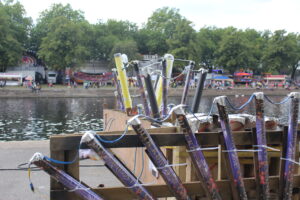A quick guide to the most popular fireworks effects
We’ve all been to fireworks displays, and some people may even be able to popular identify types of fireworks like rockets, Catherine wheels and roman candles. However, not many people can give the right names to the many different fireworks effects you’ll marvel at during a typical display, but they do have names!
So, if you know only fireworks as “the ones that go whoosh” or “the crackly ones”, you might be interested to read our quick guide to the fascinating world of fireworks effects…
- Peony. The Peony is one of the most popular and widely used of fireworks effects. It is a spherical burst of coloured stars, which explodes from the centre to an outer ring, leaving a dense concentration of stars sparkling and crackling in the centre.
- Willow. This effect looks like the branches and leaves of a weeping willow tree, hence its name. It bursts out spherically just like the Peony, but the trails start to fall outwards and downwards to create the outlines of a willow.
- Chrysanthemum. Another effect named after a flower, the chrysanthemum is very similar to the Peony. It bursts out spherically, but its sparks leave a bright, bold trail behind. It’s an explosive, colourful and mesmerising effect, one that all professional fireworks display organisers will always try to use in every display.
- Palm. This key to this effect is its name – it produces what looks like the outline of a palm tree when it bursts from the centre. You can even find some fireworks which leave a thick outline at the bottom, which resembles the trunk of the tree.
- Rings. A simple, subtle but always popular choice in a display, this effect creates rings within rings, all within split seconds. You can layer rings upon rings using multiple fireworks and a well-planned display, which can be a real crowd-pleaser.
- Fish. This effect is known by many different names, but one you might have heard of is fish, and it’s easy to see why. The shell of the firework bursts, causing small but super-fast squiggles of light to go shooting off in all directions – just like little fish swimming away!
- Spider. This very exciting firework effect, using fast burning fireworks which produce a hard and surprising burst of sparks, is often known as the spider. As the shell bursts, the stars shoot out straight and flat in a range of directions, leaving momentary trails of sparks which some say look like spiders legs. Lovely!
- Crossette. An effect which is used in practically all fireworks displays at some point is the crossette, which spits stars outwards in a seemingly haphazard way. However, look closely (or take a look at a photograph of crossette effects in a fireworks display) and you’ll see a grid-like pattern as the stars criss-cross each other. It’s a fascinating one to watch, and it’s always popular with audiences.

